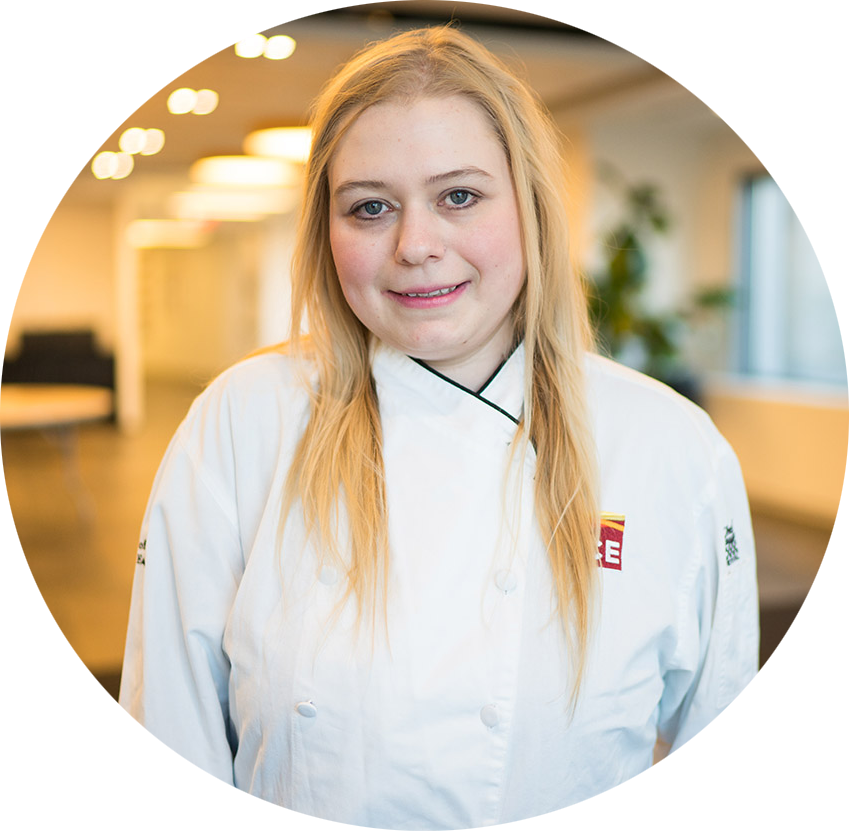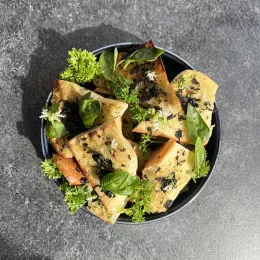Fermenting rhubarb has many advantages. The process amplifies the tangy robust notes of the beloved stalk while retaining its natural texture and pink hue.
Try muddling fermented rhubarb into cocktails, such as a springtime mojito, or use the rhubarb syrup to flavor sparkling water, iced tea or kombucha.
These fermented rhubarb, raspberry jam and ricotta pastries are perfect for entertaining or as a decadent breakfast or brunch menu item. They can be meal-prepped for the week ahead. Using sheets of puff pastry is impressive and an effective shortcut to creating fresh pastries in your home kitchen.
Ricotta cheese and raspberry jam complete this pastry, as both are low in moisture content, ensuring that the pastry dough does not become soggy. You can also try this flavor combination as toast toppings or as a filling in a precooked tart shell.
Good to Know with Chef Olivia:
- You can customize these pastries to be bigger or smaller or even make them into an open-faced sheet pan treat.
- Use an egg wash to create the perfect, glossy golden crust.
- Using a fork to seal the sides of each pastry and make vents in the top to ensure that the pastries stay intact as they bake.
- Make sure to refrigerate filled pastries before baking so that the butter can steam while baking, creating flaky layers.
- Try making these pastries in an air fryer for a quicker cooking time and extra rise.
- Using frozen rhubarb is perfectly acceptable for this ferment.

Ingredients
For the Fermented Rhubarb Ginger Syrup (Korean Cheong):
Yield: 1 quart-sized jar
- 1 pound rhubarb (or frozen rhubarb)
- 1 piece ginger
- 1 lemon, juiced
- 1/4 cups sugar
For the Fermented Rhubarb & Raspberry Ricotta Pastries & Assembly:
Yield: 12 pieces
- 1 (16-ounce) package puff pastry (2 sheets)
- 2 cups raspberry jam
- 2 cups fermented rhubarb pieces
- 2 cups ricotta or farmer’s cheese
- 1 egg
- 2 tablespoons powdered sugar
Directions
For the Fermented Rhubarb Ginger Syrup (Korean Cheong):
- Cut rhubarb and ginger into a small dice, and place in a medium bowl.
- Add lemon, and massage with 1 1/4 cups sugar.
- Transfer to a clean quart glass jar, making sure there are no air bubbles.
- Top with remaining sugar, secure lid and refrigerate.
- Stir cheong every few days to help any remaining sugar dissolve.
- The mixture should be ready for use in 5 to 7 days.
For the Fermented Rhubarb & Raspberry Ricotta Pastries & Assembly:
- Preheat oven to 375°F. Prepare a half-size sheet pan with parchment paper.
- Place one sheet of puff pastry on a work surface lightly dusted with flour. Cut the puff pastry sheet into 12 rectangles. Refrigerate for 30 minutes. Repeat with the second puff pastry sheet and refrigerate.
- Take the first puff pastry sheet from the refrigerator and place 2 tablespoons of each strawberry jam, rhubarb and ricotta in the center of each square. Brush the edges with egg wash and top each square with a second piece of refrigerated portioned puff pastry. Press down lightly on the edges to seal, then brush the tops with the remaining egg wash. Repeat with the remaining puff pastry squares.
- Using the tines of a fork, press down to seal the edges.
- Place the sheet pans in the oven and bake for 15 to 20 minutes or until puffed and golden brown.
- Remove the pastries from the oven and cool for 10 to 15 minutes. Dust with powdered sugar and serve.
More fermented recipes from Chef Olivia:






